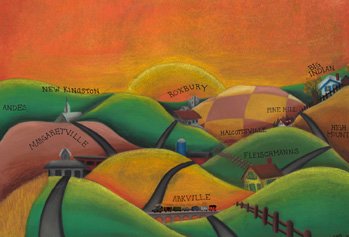| Return to Home Our Towns, A Brief History
You can read it in crystal clear rivers and streams. The Lenni Lenape followed the waterways into the forests, and found in them abundant reason to set up seasonal hunting and fishing camps. In the 1760s, the Indian trails led European settlers from the Hudson Valley into these “Blue Mountains” where they scratched out homesteads, and then vacated them for valley sanctuaries during the Revolution. When the pioneers returned in the 1780s, they established farms and hamlets, like Margaretville and Halcottsville, where streams watered livestock and crops, and powered grist mills and manufactories. Water brought heartache too, in periodic floods, and, during the 20th century, in the removal of thousands of people to make way for New York City reservoirs like the Pepacton, which today provides as much as 25% of the water needs of 9 million people. You can read our history in fields and hillsides. They are dotted with classic barns and abandoned tractors, stitched together by stone walls that once separated pastures and delineated property boundaries. Once, just about everyone here lived on a farm. The earliest settlers were tenant farmers who could not own the land, but only rent it from wealthy patent holders in a feudal system that was overturned by what’s been known as the Anti-Rent War of the 1840s. A climactic episode of that conflict was played out in Andes in 1847. Farming, of course, was never easy in this region of “two stones for every dirt.” But good grazing lands, a bracing climate and mineral rich soil supported high quality dairy herds and, in the 1920s through about 1950, a profitable cauliflower industry. Few family dairy farms remain, but in the New Kingston Valley, there are four, living legacies to our agricultural heritage. You can see signs of the past in our small towns, where gracious Victorian homes and hotels and humbler boarding houses accommodated the wealthy and the not-so wealthy when the Catskills was THE place to vacation. Fleischmanns, named for the yeast making family that endowed the village with its still-prized ballfield, was once famously crowded with tourists. The Ulster & Delaware Railroad fed the tourist trade, thrilling passengers with the climb up Pine Hill and around Horseshoe Curve near Highmount, home of the awesome Grand Hotel. Trains continued to Arkville, an important rail hub where travelers could switch to the Delaware & Northern headed to Andes, or continue on the U&D, to lovely Halcottsville on Wawaka Lake, and to genteel Roxbury. Literary naturalist John Burroughs and railroad tycoon Jay Gould grew up on neighboring farms outside of Roxbury, which recently received the prestigious “Preserve America Community” designation for its efforts to restore, promote and protect its special heritage. You can find historic treasure in our mountains, too. They have yielded lumber, spawned tanning and wood acid industries, and harbored bluestone quarries that paved New York and other great cities. In 1885, the New York State legislature created the Catskill and Adirondack Preserves to protect vulnerable mountain forests. These Forever Wild lands were thus preserved for posterity. Subsequent generations of outdoor lovers have enjoyed hiking, hunting and camping among the peaks. The highest, 4,200-foot Slide Mountain, is a short drive from Big Indian and can be climbed on well-marked trails. The mountains also made this area a skier’s haven. Belleayre Mountain Ski Center in Highmount was established in 1950; Bobcat in Andes was a popular place for decades, and Plattekill Ski Center in Roxbury has long challenged skiers, boarders and bikers. The Catskills landscape is full of clues to our history. We invite you to search them out as you enjoy our towns, and make some history of your own! |

 In this corner of the Catskills, where Delaware, Greene and Ulster Counties meet, history is written on the unspoiled landscape.
In this corner of the Catskills, where Delaware, Greene and Ulster Counties meet, history is written on the unspoiled landscape.